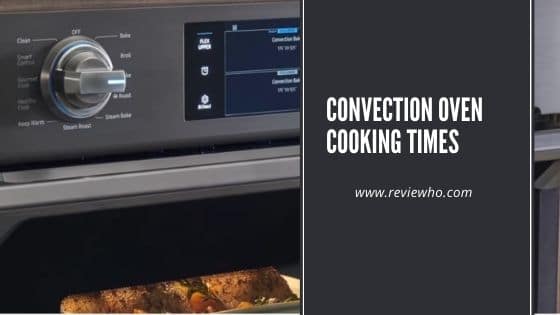Conventional and convection ovens cook using different methods. A conventional oven will cook your food by heating the air that is around the food. A convection oven, on the other hand, will do the same, but it will also circulate that air around your meal. Since it will circulate the hot air, the convection oven cooking times are less than the cooking times of a conventional oven. The food will also be prepared at a lower temperature.
Most of the recipes available are meant for conventional ovens. For that reason, it is important that you make certain adjustments to the temperature and times to avoid burning your food. In this post, we will discuss the convection oven conversion so that you can prepare a perfect meal for your family.
Convection Oven
A convection oven is an electric or gas appliance that cooks by heating the air around the food, then circulating that air using a fan. That circulation of air will reduce the convection oven cook times. The food will also cook evenly. A convection oven will give you perfect results when baking and roasting. You can also enjoy using more of the space in the oven since the air will be circulated. A convection oven will work in a similar manner as an air fryer.
The Best Time to Use a Convection Oven Instead of a Conventional Oven
When you cook food in a convection oven, it will cook about 30% faster compared to a conventional oven since the air will be forced to go around the meal. When using this method of cooking, the food will lose less moisture and very few nutrients will be lost during the cooking process.
One major aspect you should consider when choosing the best method of cooking is the pan you will use to cook. In case you will use a cooking tool that will block the circulation of air around the food, it would be pointless to use a convection oven to cook. Convection cooking would be appropriate for shallow pans and cookie sheets. Conventional cooking, on the other hand, would be much better for deep roasting pans, as well as covered pans, dishes, and casseroles.
Best Conversion Methods
There are basically three main methods of converting conventional settings to a convection oven setting. However, it would depend on the food you are cooking. The following three are the simple ways you can use without the need for a conversion calculator.
Reducing the Temperature
If you are preparing cakes, bread, or any other dessert, the main rule for conversion regular oven to convection is temperature reduction by 25 degrees Fahrenheit. You have to make sure that the convection oven times remain constant. If a recipe guides that you should cook bread for an hour at a temperature of 325 degrees Fahrenheit, you will simply cook it for the same 1 hour, but at a temperature of 300 degrees Fahrenheit.
Reducing the Time
Convection oven time conversion is another method that you can use effectively. When roasting meat, for example, the main idea is to reduce the convection oven roasting times by 25%. However, the temperature has to remain constant. Therefore, if you have a recipe that guides you to cook chicken for one and a half hours at a temperature of 350 degrees Fahrenheit, simply calculate 25% of the time given, and then deduct it from the temperature given. Maintain the temperature.
Reducing both Time and Temperature
For certain recipes, it would be advisable to reduce both temperature and time for the best results. Split the difference between the first and second methods. You should reduce the temperature by 15 to 20 degrees Fahrenheit and reduce the time by 10 to 15%.
Additional Cooking Tips for Convection Ovens
It is very important that you consider what the manufacturer tells you to do through the manual. Every oven will be delivered to you with a user guide. You should familiarize yourself with the convection oven you are using before you use it. In case you do not have a guide, you should contact the company. It may be available online.
One of the major strengths of a convection oven is the circulation of hot air. Avoid covering the racks with foil so that the food can be cooked from all sides. You should leave a space of 1 inch around the pan.
If you want perfect browning on your meal, you should use a shallow pan. The cookie sheets should also be rimless. Most of the ovens that are available in the market have racks and pans that will lift roast. The air will, therefore, flow all around the food.
Guidelines for Roasting
For Poultry and Meats
If you are roasting poultry, you do not need to preheat the oven. Place the meat directly on the rack in the pan for perfect browning. The convection cooking times will be reduced by around 30% if you will not reduce the temperature. You will get certain convection ovens that have a special mode for roasting, which will brown the top and bottom at the same time. You will also find some that provide a heat surge when it starts cooking.
For Unstuffed Poultry
Avoid reducing the temperature at all when you are cooking skinny meat, small meat, or unstuffed poultry.
For Large Meats and Stuffed Turkeys
If you are cooking large meat or a large turkey that is stuffed, you should reduce the temperature by 25 degrees for a certain period or the entire cooking time. The meat will become juicier and it will shrink less when the temperature is lower.
Summery
Convection baking times are less than conventional baking times. The main idea of the convection oven will make it easier to cook your meal while enjoying perfect results. You must consider the guidelines above if you want to get perfect results for your recipe. The conversions above will not require any calculator. They are very easy to follow.
Related:
- What Is A Halogen Convection Oven
- What is a Convection Microwave Oven
- Toaster Versus Toaster Oven
- The Best Under Cabinet Toaster Ovens
Feel free to share your observation with me in the comments section!
Also, if you find the information in this post to be useful, be sure to share this post with your friends on Facebook, Twitter, and Pinterest.




